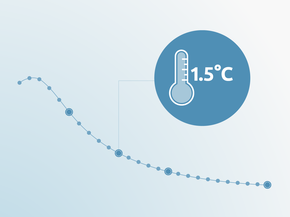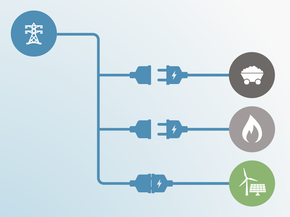Current Policy Projections
Economy-wide
With currently implemented policies (based on the “with existing measures” scenario of the 3rd Biennial Report), Switzerland is expected to reach an emissions level of 47MtCO2e by 2020 and 41 MtCO2e by 2030 (excluding LULUCF), equivalent to 17% and 21% below 1990 levels (excluding LULUCF), which constitutes a slight increase in comparison to last year’s projections. With its current plans, Switzerland falls short of meeting its 2030 target of a 30% national reduction below 1990 levels suggested by the Federal Council, let alone the overall 50% reduction below 1990 levels by 2030 set out in its NDC, which does include the intention to partly use carbon credits from international mechanisms. With its third CO2 act (planned policy scenario, which is planned to begin in 2021 and assumes a strengthening beyond the already stipulated strengthening of current legislation) Switzerland hopes to achieve a 35% reduction below 1990 levels by 2030 and thus meet its national emissions reduction target.
The increased emissions projections compared to our last assessment stem from updated Swiss emissions projections submitted to the UNFCCC (Swiss Confederation, 2018). In particular, we reconsidered its transport demand, and the projected use of biofuels and reduced share of electric vehicles. While considered a frontrunner for its investment and recognition of the opportunities from modal shift to trains, Switzerland will have to do more work to achieve the phase-out of fossil fuel cars by 2035 that we have identified as one of the key short-term steps to limit warming to 1.5°C (Kuramochi et al., 2018) .
The most relevant cross-sectoral policies and measures include the two past CO2 Acts (1999, 2011), the CO2 levy on heating and process fuels and the emissions trading scheme. More detail on sectoral policies can be found below. The Swiss Energy Strategy’s main objectives are the reduction in energy consumption, broadening of electricity supply and expansion and restructuring of electricity transmission grid and energy storage (further details below).
Energy supply
The Energy Law, which went into effect in January 2018, paved the way for a change in the national energy policy and constitutes a major step in the implementation of the Swiss Energy Strategy 2050. This work was initiated after the nuclear catastrophe in Fukushima (Schweizerische Eidgenossenschaft, 2017).
The three strategic objectives of this Strategy are:
- Reduction in energy consumption: the new Energy Act contains targets to achieve a reduction in per capita energy consumption by 43% by 2035 below 2000 levels and a reduction in per capita electricity consumption of 13% below 2000 levels by 2035. With a decrease in per capita energy consumption between 2000 - 2015 of around 16% (Climate Action Tracker, 2018), Switzerland is on the path towards achieving the first target, even if some acceleration is needed.
The situation looks different for power: in 2015 an average Swiss citizen consumed 7001 kWh of power, over 22% more than an average EU citizen (Climate Action Tracker, 2018). Policy measures to achieve these targets include minimum requirements for appliances and other regulations, efficiency bonus and measures to raise public awareness.
- Broadening of electricity supply: to replace nuclear energy in the long-term and decrease electricity imports, the Energy Law also includes an indicative target for 11.4 TWh of domestically produced renewable energy (excluding hydro) by 2035 and 37.4 GWh in 2035 of hydropower (Schweizerische Eidgenossenschaft, 2016a). For non-hydro renewables, that means a more than fivefold increase from 2015 (The World Bank, 2017). This corresponds to a share of 20% of power consumed in Switzerland (excluding hydro), and almost 67% for hydropower. It is expected that 480 million Swiss francs (USD$498 million) will be allocated to fund the investment in energy each year (Climate Action, 2017). Fossil-fuel based electricity generation may also be expanded by constructing gas-fired combined-cycle power plants to ensure temporary power balancing as the share of variable renewables increases. The emissions caused by new fossil fuel-based power plants must be compensated by buying emissions allowances in the emissions trading scheme. Currently. it is unclear whether these plants will be needed to cover future electricity demand (Swiss Confederation, 2018).
- Expansion and restructuring of electricity transmission grid and energy storage: To accompany the increasing share of intermittent renewable energy (wind, solar) Switzerland plans to expand and restructure the transmission grids and pool power plants to ensure temporary power balancing, as well as storage and reserve capacities.
Decreasing energy consumption, especially if combined with a decreasing carbon intensity of the energy sector, will have a positive impact on reducing emissions. In 2013, almost 79% of Switzerland’s greenhouse gas emissions were coming from the energy sector (Schweizerische Eidgenossenschaft, 2016b). With 33 tCO2/TJ, the carbon intensity of its energy was 48% lower than that of the energy consumed in the EU (The World Bank, 2017). With only 2.3% of electricity generated in Switzerland coming from fossil fuel power plants, and the rest mostly from hydro power plants, nuclear and, increasingly, wind and solar, the carbon intensity of its power sector is relatively low (Verband Schweizerischer Elektrizitätsunternehmen, 2017).
Expansion of hydropower is an important component of the Energy Strategy 2050, as a complement to the energy transition in Switzerland. Low wholesale electricity prices have depressed investment in hydro power, with prices often falling below the cost of generation from these plants. The new Energy law has two provisions to remedy this for plants with a capacity greater than 10 MW (IEA, 2018). These include investment aid and a market premium for power generated.
Industry
Similar to the EU, Switzerland also uses an emissions trading scheme (ETS) to lower emissions from large energy intensive entities. However, the Swiss ETS is much smaller than the European ETS, not only because of the smaller market but also due to the fact that the emissions generated by 54 companies in the power, cement, pharmaceutical, refinery, paper, district heating, and steel sectors covered by the scheme represent only 10% of the overall emissions. Its cap - set at 5.63 MtCO2 for 2013 - is reduced by 1.74% a year to reach 4.91 MtCO2 in 2020 (13% reduction on 2013 levels) (Mission of Switzerland to the European Union, 2017).
An examination by the Swiss Federal Audit Office came to the conclusion that, in its current form, the Swiss ETS “generates hardly any incentives for reductions“ (Swiss Federal Audit Office, 2017). The audit office found several regulatory shortcomings, calling the impact of the ETS into question. High number of emissions allowances allocated free of charge decreased the willingness of companies to invest in energy efficiency.
An annual decrease of the cap by 1.74%, which was below the overall emissions reduction, has led to an oversupply of allowances and consequently low prices (ICAP, 2017). Without any reforms, the audit office found the oversupply of allowances would reach 4.5 million certificates in 2020, equivalent to 95% of the overall cap in 2013 (Swiss Federal Audit Office, 2017). The small size of the market further worsens the oversupply of allowances in case of an unexpected production stoppage or increase, and the resulting sudden changes in demand or supply of allowances.
To deal with the allowances’ price volatility, in 2010 the European Commission and Swiss government opened negotiations on linking both carbon markets. In August 2017, the European Commission tabled a proposal to finalise the agreement with Switzerland. Conditional on European Parliament and EU Council of Ministers approval, it will enter into force in 2018 (European Commission, 2017). Integration of both markets would allow companies to trade emissions on a bigger market, although the European Union’s Emissions Trading Scheme is also plagued by a significant and growing oversupply of emissions allowances (see CAT’s assessment of the EU). The Federal Audit Office recommends the establishment of an appropriate control mechanism “at the legislative level whereby over or undersupply of the market can be responded to and unused emission allowances can be removed from the system” (Swiss Federal Audit Office, 2017).
Transport
Compared to earlier projections by the Swiss Confederation in 2016 (Schweizerische Eidgenossenschaft, 2016b), the latest data submitted to the UNFCCC project an increase of 27% in emissions from the transport sector in 2030 (Swiss Confederation, 2018). These changes are the result of changes in assumptions about the future development of transport demand, in particular a reduction of the projected use of biofuels and the share of electric vehicles (Swiss Confederation, 2018).
In line with the EU standards, the Energy Strategy 2050 includes CO2 emissions regulations for newly-registered vehicles that will decrease to 95 gCO2/km in passenger cars by 2020, and to 147 gCO2/km for utility vehicles and light semi-trailers (Schweizerische Eidgenossenschaft, 2016a). However, newly-registered vehicles have consistently underperformed and not complied with these targets. In 2017, over 300,000 new passenger cars were tested for compliance. The average emissions resulting from these tests of these vehicles were 134.1 gCO2/km, which is higher than the target (130 gCO2/km) as well as the reported value of 133.6 gCO2/km for 2016 (Bundesamt für Energie, 2018a). While there is a need to tighten compliance, it is important to note the pressure the government placed on importers to scale up their ambition with respect to electric vehicles. From 2025 onwards, the Swiss Federal Council has proposed to further decrease the targets in line with the European Union.
Incentives for Zero Emissions Vehicles (ZEVs) are currently relatively few compared to frontrunner countries such as Norway or the Netherlands (with, respectively, 29% and 6% new electric cars in 2015). Buyers do not receive a premium as they do, for example, in Germany, but are freed from the annual motor vehicle tax (KfZ-Steuer). In 2016 2% of new passenger cars in Switzerland were electrically charged vehicles, above the 1.5% average among Western European new cars (ACEA, 2017). There is reason for optimism on this front. The association of car importers (Automobilimporteure) announced its aim to achieve a 10% share of electric vehicles in new sales by 2020, triggered by the need to reach their CO2 emissions targets. The federal government is also in the process of establishing a roadmap that will have a goal to identify actions and measures to increase the share of electric vehicles in new registrations to 15% by 2022. To this end, a first round table has been initiated with representatives of the cantons, cities, and various industries, that is currently developing the exact format of the roadmap (Bundesamt für Energie, 2018b).
Switzerland’s recognises the need to reduce unnecessary motorised mobility, shift traffic from road to more environmentally friendly modes, and to improve intermodal transport chains and interconnectivity.
Switzerland’ freight policy requires transalpine freight transport to shift from road to rail, with a heavy vehicle charge in place to achieve this goal, which was first implemented in 2001 and is considered “relatively successful” (Swiss Confederation, 2017). The number of freight trucks crossing the Swiss Alps by road in 2007 (1.4 million trucks) was some 10 per cent down on the 2000 figure (1,263,000). But since the weight limit was lifted, the tonnage transported by these freight trucks also went up by 5%. The modal shift from road to train both for freight and passengers is further supported by ongoing refurbishment and extension of the rail network, including two new base tunnels.
Buildings
Energy efficiency standards for buildings are decided at the level of regions. Communes are allowed to introduce even stricter standards (Immopro, 2017). In 2014 the regional governments agreed that new standard - MuKEn14 – should be implemented by all regions before 2018 and become binding in 2020. For new builds, the standard amounts to 35 kWh/m2 for both, single and multi-family houses. For warehouses the standards are even stricter and shouldn’t exceed 20 kWh/m2. Each house should also be equipped with renewable, source of power amounting to at least 10 W pro m2 of the living space (EnFK, 2014).
These targets have already been met by some of the buildings complying with the Swiss “Minergie” standards. There are three major categories: Minergie houses shouldn’t consume more than 55 kWh/m2 for new single houses and 90 kWh/m2 for renovations. For Minergie-P the standards are 50 kWh/m2 and 80 kWh/m2 respectively. For Minergie-A the standards are 35 kWh/m2 for both, new builds and renovations. By April 2017 there were a total of 43.148 Minergie certified buildings in Switzerland (Minergie, 2017).
The Energy Strategy 2050 will allocate 450 million Swiss francs (USD$ 467 million) from the Cantons and CO2 levy to reduce buildings’ energy use by 43% below 2000 levels by 2035. It plans to achieve this by allowing an option for allocating energy-efficiency investment costs to the two following tax periods, and a tax deduction of demolition costs when replacing older buildings (Federal Office of Energy, 2017).
Agriculture
The Climate Strategy Agriculture aims to reduce agricultural emissions by at least one third, and includes both adaption to climate change in the agricultural section - and reducing emissions. Switzerland, through the Strategy, recognises that climate change challenges in the agriculture sector require changes in agronomic practices and procedures as well as industry, trade, and consumer behavioural changes (Federal Office for Agriculture, 2017).
Forestry
The Forest Policy 2020 aims to coordinate the ecological, economic and social demands on forests, managing forests in a sustainable manner. One objective of the Policy is to utilise forest management and wood use to contribute to reducing CO2 emissions and conserve Swiss forests to enhance their resilience (Federal Office for the Environment, 2013).
Waste
Disposal of combustible solid wastes on landfills has been prohibited since 2000. Further measures in the waste sector include the ordinance on the avoidance and management of waste which promotes closed-loop material flows. Further improvements could be made in the reduction of environmental pollution and strengthening the reliability of the waste removal system as a whole (Swiss Confederation, 2018).
Further analysis
Latest publications
Stay informed
Subscribe to our newsletter






